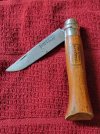" . . . if you want to keep your Opinel Carbone blade that sharp, I have one simple piece of advice. Don’t use it. At all. If you cut anything or have anything hard touch the blade edge, your factory edge is gone, long gone."
I have never liked the factory edges of Opinels. They are poorly finished IMO. I always change the edge on them and seldom have to sharpen after that. I strop them regularly as I cut pretty abrasive material on the farm: Cardboard, baling twine, feed bags. I also cut apples and carrots to give meds to horses, open mail and packages, and trim splintered wood.
"I used my digital calipers to carefully measure the blade height of the Carbone blade near the back, close to the handle (which I do for all knives I review). Just touching the blade to the calipers rolled the steel at that spot, and it was clearly evident when running test slices on 20# paper. In fact, with every slice in the paper I made, more rolled edges began to appear, this time near the Yatagan edge curve where more of the cutting was done. Seriously, the burr was easily felt by my finger. I used the blade to cut paper just 3 dadburn times."
To be honest, I do not believe you. The edges of my Opinels never roll unless I am cutting harder objects. Once a year I cull the doves out of the sheds and take a rabbit or two. In processing them, bones may ding the edge. Paper does not do this.
"You’ll have a great edge forever (until the edge rusts away). If you don’t live in Death Vally or the Gobi Desert, which means rust is a problem, you can keep your Opinel knife deep inside a 5 lb. sack of dry rice. That will help a little bit."
I have been using Opinels in every climate zone in North America since the 80s. In the Pacific NW and the deep south the Carbone blades have not rusted, only patinated, and the handles have not warped. In the desert SW the handles have not split. They have done good work in Alaska and Canada and have hummed along nicely fishing and canoing. The handle joints do swell, but I have never used the mineral oil solution. I disassemble the knife and sand open the joint so that the blade can swing free. Any swelling makes the movement a little slower, any drying makes the movement freer. I only need to do this once.
Your review was intensive, but dishonest in places. It was tendentious. It was snarky, but repetitively so. I like your sense of humor, but you went back to the same comedy well too many times and it diluted your point.
And what was that point? In short, your conclusions are that the Opinel is obsolete, does not perform well, and should be ashamed to still exist as a company. The knife still does its job well, lasts a long time, and people like them enough for the company to stay in business, so your conclusions are not valid. As opinions, they amount to, "What a yucky knife."
Now I'm off to do barn chores and train horses with a rust-free, twenty-five year old, razor sharp Opinel N°10 Carbone in my pocket.



